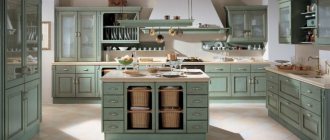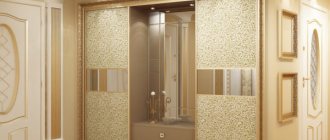One of the important issues that needs to be decided when ordering a new kitchen concerns the height of the hanging cabinets. Should they be tall or can they be made small? Do tall cabinets have to reach the ceiling? In what case should you not do this? Let's figure it out.
First of all, it should be noted that the height of the upper cabinets is a matter of taste and personal preference. Much depends on the style of furniture, the size of the room, and the design of the ceilings. But it’s still worth admitting that a small gap between the cabinets and the ceiling looks quite ridiculous - like a flaw or an omission. Therefore, although this is a matter of taste, the rule is formulated by itself: either the distance should be decent, or there should be none at all.
These cabinets are begging to be taller. Why this small gap?
The distance from the cabinets to the ceiling is logical
And here it is illogical
Why is this distance between the cabinets and the ceiling?
Why not make these cabinets go all the way to the ceiling?
That is, yes - raising cabinets to the ceiling is not at all necessary. But then it is better to make them low, leaving at least 30-40 cm of free space above them. It looks beautiful and... logical.
Upper kitchen cabinets to the ceiling: pros
1 . Fashionable. Yes, this is a trend now. In new design projects, kitchens that do not reach the ceiling are becoming increasingly rare (when it comes to rooms with a standard height).
2. Clean. Dust does not accumulate on cabinets that reach the ceiling. They do not need to be wiped from above by jumping on chairs, tables or stepladders.
3. Order. There is no temptation to clutter the top of your cabinets.
4. Slim and graceful appearance. It is believed that elegant kitchens with a classic design should go right up to the ceiling. In this case, a small gap between the cabinets and the ceiling is usually formed by a cornice that encircles the perimeter of the room.
5. Additional storage space. The higher the cabinets, the more useful shelves and drawers there are. This is especially true for small kitchens. But even in large ones, additional storage space is rarely superfluous.
Multi-level kitchen sets
The modern approach of designers to designing kitchen sets today is meeting their clients' needs. Therefore, their developments take into account the solution to a number of problems associated with the comfortable use of furniture in the kitchen. Such developments include multi-level kitchen sets . Furniture of this type is not designed on one horizontal line, but combines surfaces of different heights.
So, for example, the work surface may have a stepped tabletop , which will allow the cook to periodically relieve the load on the back when frequently changing the position of the body and hands. For the washing area, it is better to make a slightly higher level - 100 cm from the floor , so that it is convenient to wash dishes or cut fish in the sink. The working surface for cutting vegetables or rolling out dough should be of medium height - 90 cm, so that it is comfortable for your hands to rest on the table or work. The cooking zone can be lowered below the average level - 80 cm , to make it more convenient to place pots and cook food.
Upper kitchen cabinets to the ceiling: cons
1. Higher price. It's simple: the larger the cabinets, the greater the volume of materials used and, accordingly, the higher the final cost.
2. Difficult access. The very top shelves and drawers can be difficult to reach. Therefore, they are often empty. However, it cannot be said that the upper tiers of furniture take up space in vain, because they perform one of their main functions - decorative.
3. Insufficient level of convenience and ergonomics. To get something from the highest level, you need to stand on a chair, stool, or stepladder. Having to constantly get on and off the “lifts” is not much fun. In addition, it may not be safe.
4. Visual overload. Even in a large kitchen, if there are a lot of upper cabinets, a “refurbishment” effect can occur. It will seem that the cabinets have literally taken over the space. This, of course, will not add comfort to the interior.
For a compact kitchen, such “re-cabineting” is more dangerous - the room will become even more cramped, oppressive, and similar to a pencil case. This is especially noticeable if the cabinets are equipped with dark fronts.
Here's a paradox: a small kitchen needs additional storage space, but at the same time you want to maintain at least some semblance of space in it. We have to maneuver and look for compromises.
Based on cabinet sizes
Standard size cabinets are considered to be a 60 cm cabinet. If you decide to use a custom closet service, then be prepared to open your wallet a little wider. The inflated price is due to the fact that the product will not be manufactured according to a ready-made template.
- Height is less than 180 centimeters. In this case, it is worth choosing cabinets whose dimensions vary from 60 to 70 centimeters.
- Height is more than 180 centimeters. Here you should choose larger models. 80-90 centimeters will seem quite comfortable to you.
Note: these dimensions are based on the assumption that the cabinets will not hang higher than 65 centimeters above the countertop level.
Kitchen cabinets to the ceiling: when are they appropriate and when are they not?
The leading aspect is the height of the room . If it is 240 cm or less , you can order standard cabinets up to the ceiling without hesitation.
With a kitchen height of 240 to 300 cm, the cabinets can be made either high (to the ceiling) or low. But we remember that it is better to leave a larger distance from the cabinet to the ceiling (from 30-40 cm).
If the room is higher than 300 cm , you should not raise cabinets to the ceiling. This design will look too bulky and unnatural. And it will be almost impossible to use the cabinets, then what’s the point? No benefit, no aesthetics.
If the ceiling is decorated with beams, coffers or other decorative elements, cabinets resting against it can cause visual confusion and create unnecessary asymmetry. The beautiful ceiling should not be touched; it would be better if the cabinets were lower.
But this does not apply to simple and smooth ceiling tiers. If the ceiling above the work area is slightly lowered, the top of the cabinets can be rested against it.
When developing the design of a new kitchen, it is worth taking into account the individual characteristics of the owners. Including their age. So, if the kitchen is intended for older people, you should not make very tall cabinets. The need to climb benches and ladders at an advanced age can cause injury.
Proposed Standards
You need to pay attention, first of all, to the ceiling height of your kitchen space; if the ceiling is very large, then you can hang cabinets at an acceptable height from the plane of the countertop. If, for example, the ceiling is not high, then it may not be possible to raise the cabinets to the required height - they will rest against the ceiling. From the plane of the countertop to the beginning of the top box of cabinets that are hung, the distance must fully meet the following expectations of the cook or any kitchen resident:
- comfort of using the work surface with a slight forward tilt;
- the height of cabinets that are suspended, if a person is 165 cm tall, must be no less than 50 cm;
- the height of cabinets that are suspended, with a person’s height of 185 cm, can be from 50 to 90 cm;
- the bottom part of the box of cabinets located on top must necessarily be slightly less than eye level;
- hands on the tabletop should be at an angle of 15-20 degrees;
- the height of the lower belt of a kitchen set with a height of 165 cm must be no higher than 820 mm;
- the height of the lower belt of a kitchen set with a height of 185 cm must be no higher than 900 mm;
- If human height is 180 cm, then the standard height of the cabinets located on top will be 60-70 cm, and the distance between them and the surface of the countertop will be 65 cm.
The connection to a person’s height and the use of a particular countertop and placement of a different height of cabinets is not accidental. After all, if the cabinets hang too low, then this will constantly interfere with your cooking on the countertop surface. And if the distance between the cabinets and the tabletop is too large, this will create additional awkwardness, such that you will always have to reach the shelves or substitute a stool to reach the top one.
Kitchen cabinets to the ceiling: implementation options
If the height of the room is 240 cm , you can hang standard cabinets. They will be neither too tall nor overly bulky. The joint can be decorated with a cornice if desired.
If the kitchen is higher than 240 cm (but not higher than 270 cm) , you can go one of two ways. First: hang the cabinets slightly below the ceiling, covering the remaining distance with a decorative front panel and, if desired, a cornice. The top edge will thus be purely decorative, without functionality.
The second way: order upper cabinets in two tiers. Or, in other words, double.
The design options for the double top are varied:
1. Both levels are equal in height;
2. The first level is higher than the second;
3. The facades of both levels are blank;
4. The facades of the first level are solid, the second are glazed (lighting would be appropriate here) or vice versa;
5. Both levels are the same depth;
6. The second level is deeper than the first. In other words, the top of the kitchen is equipped with a mezzanine. The lower level has a standard depth (30 cm), and the depth of the mezzanine can be increased to 60 cm.
When choosing the last option (kitchen with mezzanine), do not forget about ergonomics: deep mezzanines should be located higher than the height of the owners.
If the room is higher than 270 cm , you will have to order a two-level top. But if this design is not to your taste, there is still a way out.
This solution is suitable not only for a high room, but also for any other. To avoid leaving space above the cabinets, you can simply lower the ceiling. Or rather, mount the box above the work area and rest the cabinets against it. Kitchens of this type are also called built-in.
When ordering a kitchen with a two-level top, make sure that everything is more or less symmetrical. Tall cabinets with asymmetrical doors can create clutter and create visual chaos.
How to raise old standard height cabinets to the ceiling?
And for such cases, methods have long been found.
1. Hang the cabinets from the ceiling, decorate the joint with a cornice. Place open shelves under the cabinets to balance the composition.
2. Mount a decorative (front) panel on top of the cabinets up to the ceiling, covering the joint with a cornice. Ideally, the panel should be the same color as the facades.
3. Build an upper level in the form of mezzanines, cubic cabinets or open shelving.
Extended and painted
Extended and painted
If you're planning a kitchen remodel without changing furniture, take these ideas to heart. Simple techniques will allow you to give a new look to your boring headset.











